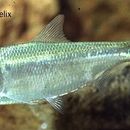Diagnostic Description
provided by Fishbase
Belly with 14 to 18 (usually 16 to 17) - 11 to 14 (usually 12 or 13), total 25 to 31 (usually 20 to 30) scutes. Anterior arm of pre-operculum with fleshy triangular area above, not covered by third infra-orbital bone (see N. come). Edge of lower jaw strongly flared outward. Pectoral axillary scale rudimentary or absent. Hind edge of scales not toothed. A dark spot behind gill opening.
- Recorder
- Crispina B. Binohlan
Life Cycle
provided by Fishbase
In more northerly part of its range, spawning may take place several times over the year but is probably annual in southern localities.
Migration
provided by Fishbase
Potamodromous. Migrating within streams, migratory in rivers, e.g. Saliminus, Moxostoma, Labeo. Migrations should be cyclical and predictable and cover more than 100 km.
- Recorder
- Crispina B. Binohlan
Morphology
provided by Fishbase
Dorsal spines (total): 0; Analspines: 0; Analsoft rays: 17 - 26
- Recorder
- Crispina B. Binohlan
Trophic Strategy
provided by Fishbase
Both larval and juvenile bony bream are pelagic (Ref. 26397). Juveniles feed on zooplankton initially then at 5-6 cm length, they switch to a diet of detritus and algae (Ref. 26401). The young are often found near macrophytes and other submerged terrestial vegetation. During the day, they are found in groups in shallow backwaters or bays (Ref. 26399).Adults in general, live in a variety of habitats including shallow backwaters and artesian bones, over mud, clay, and sand. Also floodplain, lagoons, main river channels, and sandy lowland creeks in still or flowing water or clear to very turbid waters. Adults prefer open water (Ref. 6390).
- Recorder
- Crispina B. Binohlan
Biology
provided by Fishbase
Occur often far up rivers, but also in estuaries and in Lakes Alexandrina and Albert near mouth of a river (Ref. 188). Most commonly inhabit streams coursing through relatively dry eucalyptus-scrub or desert areas, preferring sluggish or quiet waters (Ref. 5259, 44894). Also found in saline lakes (slightly less salty than sea water). Tolerant of water temperatures between 9° and 38°C and pH 4.8-8.6. Although these fish have a wide tolerance of temperature and pH, they are susceptible to oxygen depletion and are usually the first to perish when ephemeral habitats begin to dry up. Common length is 15-20 cm (Ref. 44894). Frequently noted in large shoals that feed on benthic algae; also feed on insects and small crustaceans. Spawning may occur repeatedly in the north with a peak during the wet season; probably annual in the south (Ref. 5259, 44894).
- Recorder
- Crispina B. Binohlan
Importance
provided by Fishbase
fisheries: commercial; bait: usually
- Recorder
- Crispina B. Binohlan

